

Ajanta Caves. The Ajanta Caves (Ajiṇṭhā leni; Marathi: अजिंठा लेणी) in Aurangabad district of Maharashtra, India are about 30 rock-cut Buddhist cave monuments which date from the 2nd century BCE to about 480 or 650 CE.[1] The caves include paintings and sculptures described by the government Archaeological Survey of India as "the finest surviving examples of Indian art, particularly painting",[2] which are masterpieces of Buddhist religious art, with figures of the Buddha and depictions of the Jataka tales.[3] The caves were built in two phases starting around the 2nd century BCE, with the second group of caves built around 400–650 CE according to older accounts, or all in a brief period of 460 to 480 according to the recent proposals of Walter M.
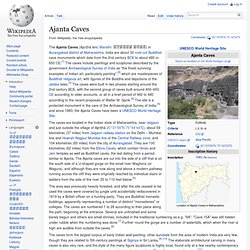
Nalanda. Nālandā was an ancient centre of higher learning in Bihar, India.[1] The site is located about 88 kilometres south east of Patna, and was a religious centre of learning from the fifth century AD to 1197 AD.[2][3] Nalanda flourished between the reign of the Śakrāditya (whose identity is uncertain and who might have been either Kumara Gupta I or Kumara Gupta II) and 1197 AD, supported by patronage from the Hindu Gupta rulers as well as Buddhist emperors like Harsha and later emperors from the Pala Empire.[4] The complex was built with red bricks and its ruins occupy an area of 14 hectares. (488 by 244 metres)[5] At its peak, the university attracted scholars and students from as far away as Tibet, China, Greece, and Persia.[6] Nalanda was ransacked and destroyed by a Turkish Muslim army under Bakhtiyar Khilji in 1193.
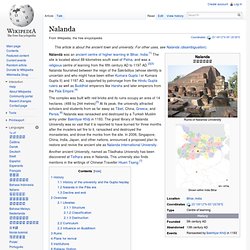
Another ancient University, named as Tiladhaka University has been discovered at Telhara area in Nalanda. History[edit] Ajanta Caves. The Huntington Archive. The Historical Interaction between the Buddhist and Islamic Cultures before the Mongol Empire – 12 The Establishment of Buddhist Kingdoms by the Uighurs. Alexander Berzin, 1996lightly revised, January 2003, December 2006.
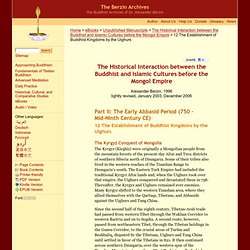
Does Newly Excavated Buddhist Temple Provide A Missing Link? The Buddhist firmament is abuzz with word of amazing discoveries at the newly excavated site of Deorkothar in Madhya Pradesh, India.
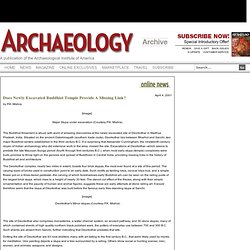
Situated on the ancient Dakshinapath (southern trade route), Deorkothar lies between Bharhut and Sanchi, two major Buddhist centers established in the third century B.C. It is surprising that Alexander Cunningham, the nineteenth-century doyen of Indian archaeology who did extensive work in the area, missed the site. Excavations at Deorkothar--which seems to predate the late Mauryan-Sunga period (fourth through first centuries B.C.), when most early stupa (temple) complexes were built--promise to throw light on the genesis and spread of Buddhism in Central India, providing missing links in the history of Buddhist art and architecture.
The Deorkothar complex, nearly two miles in extent, boasts four brick stupas, the most ever found at a site of this period. The varying sizes of bricks used in construction point to an early date. P.K. Share. Buddhism and the Roman world. Extent of Buddhism and trade routes in the 1st century CE.

Several instances of interaction between Buddhism and the Roman world are documented by Classical and early Christian writers. Pandion embassy[edit] "ΖΑΡΜΑΝΟΧΗΓΑΣ ΙΝΔΟΣ ΑΠΟ ΒΑΡΓΟΣΗΣ" ("Zarmanochegas from Barygaza in India") Buddhist culture and pre-Christian Greece[edit] From the time of Jesus or soon after: a statue of Siddartha Gautama preaching, in the Greco-Buddhist style of Gandhara, present-day Pakistan Will Durant, noting that the Emperor Ashoka sent missionaries, not only to elsewhere in India and to Sri Lanka, but to Syria, Egypt and Greece, speculated in the 1930s that they may have helped prepare the ground for Christian teaching.[5] Mauryan proselytizing[edit] Ashoka ascended the throne of India around 270 BCE. Records from Alexandria, long a crossroads of commerce and ideas, indicate that itinerant monks from the Indian subcontinent may have influenced philosophical currents of the time.
Vakataka dynasty. For the poet Harishena, see Harisena The Vākāṭaka Empire (Marathi: वाकाटक) was a royal Indian dynasty that originated from the Deccan in the mid-third century CE.
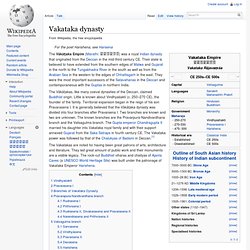
Vidisha. Vidisha is a city in the state of Madhya Pradesh, India, located near the state capital Bhopal.
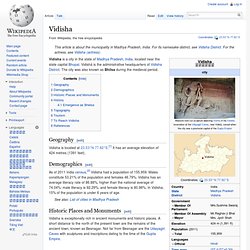
Vidishā is the administrative headquarters of Vidisha District. The city was also known as Bhilsa during the medieval period. Geography[edit] Vidisha is located at WikiMiniAtlas 23°32′N 77°49′E / 23.53°N 77.82°E / 23.53; 77.82.[1] It has an average elevation of 424 metres (1391 feet). Room 33a: Amaravati. Vaishali (ancient city) At the time of the Buddha, Vaiśālī, which he visited on many occasions, was a very large city, rich and prosperous, crowded with people and with abundant food.

There were 7,707 pleasure grounds and an equal number of lotus ponds.